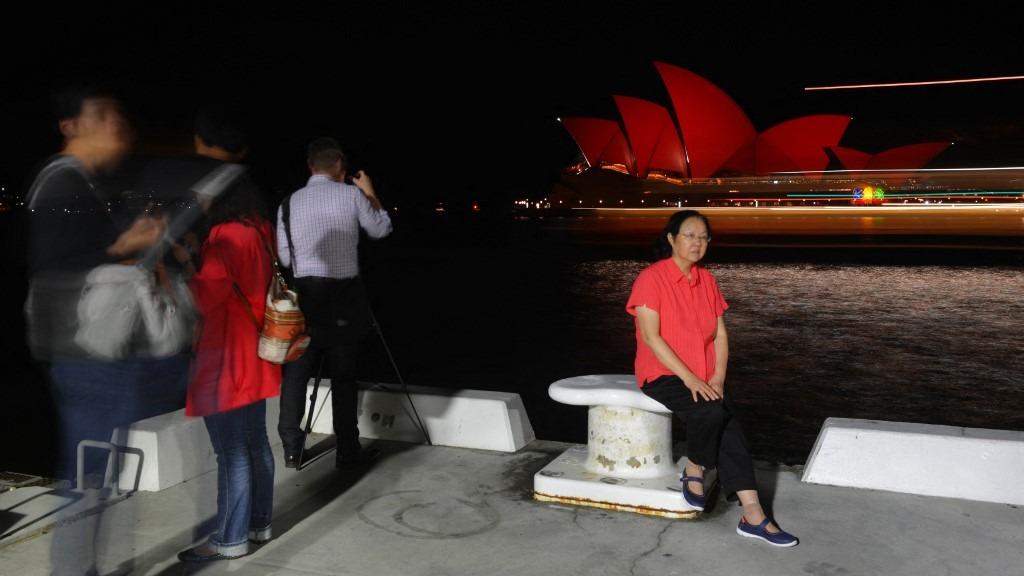With fresh campaigns aimed at major market, industry hopes to lure back visitors after the pandemic setback
 This long exposure photograph shows Chinese tourists taking photos in front of the Sydney Opera House which is lit up red to welcome in the Lunar New Year of the Monkey in Sydney, Feb 8, 2016. (PHOTO / AFP)
This long exposure photograph shows Chinese tourists taking photos in front of the Sydney Opera House which is lit up red to welcome in the Lunar New Year of the Monkey in Sydney, Feb 8, 2016. (PHOTO / AFP)
Australia’s premier travel industry trade event, the Australian Tourism Exchange, had one word bandied about the most during its recent five-day conference, and that was China.
Held at the Gold Coast Convention and Exhibition Centre in Queensland state from April 30 to May 4, the annual event attracted 2,300 delegates from 30 countries, with China having the biggest contingent comprising 113 people representing all aspects of the sector.
Prior to the pandemic, China was Australia’s biggest visitor source market, with 1.4 million tourists in 2019 who spent a total of A$12.4 billion ($8.3 billion at current exchange rate).
Despite an end to global travel restrictions, tourism to Australia has been slow to take off after the COVID-19 setback.
The government agency responsible for attracting international visitors to Australia, Tourism Australia, is however confident about the future.
The agency’s managing director, Phillipa Harrison, told China Daily: “China was our number one market in terms of both visitation and spend before the pandemic and it is great to see Chinese travellers returning to Australia.
“There is no doubt visitation levels will take time to bounce back to 2019 levels, and aviation capacity still needs to rebuild, but there are encouraging signs.”
She said the latest international visitor arrivals data shows that Australia welcomed more than 40,000 travellers from China during February, up from around 15,000 in the previous month.
“The numbers show Australia remains a top destination for Chinese travellers,” Harrison said.
In March, Tourism Australia launched its ‘Don’t Go Small, Go Australia’ campaign in China, and as capacity comes back the agency plans to go live with its ‘Come and Say G’day’ campaign in the key market.
During their visit for the Australian Tourism Exchange conference, the Chinese delegation was given red carpet attention, from surfing lessons to access to some of the country’s premier tourist attractions.
But Chinese tourists have not returned as quickly as the industry had hoped. Tourism Australia’s internal projections suggest the numbers will not recover until 2026.
Even so, Australian states are busy trying to rebuild the largest foreign tourist market.
Mark Olsen, CEO of regional tourism organization Tourism Tropical North Queensland, said China was the region’s largest international market with 190,000 visitors a year before the pandemic.
“We are seeing friends and families arriving in Cairns as well as the Chinese students returning to university,” he said.
“Direct flights are needed to Cairns, and we welcome any movement with China’s list of preferred destinations for group travel,” he told China Daily.
Erik de Roos, executive director of marketing at the South Australian Tourism Commission (SATC), said that prior to the pandemic, China was the largest inbound market into South Australia.
“While the pandemic had a huge impact on international travel around the globe, we are firmly focused on rebuilding our global markets — worth a combined A$1.2 billion pre pandemic — and China is an important part of this,” he said.
He said that SATC has maintained a presence in China throughout the pandemic to ensure South Australia was ready to “jump out of the blocks” when the time was right.
Executives from Tourism Australia and state tourism bodies will travel to Chengdu next month for the Chinese launch of the ‘Come and Say G’day’ advertising campaign, which was unveiled to the rest of the world in October last year.
According to Tourism Australia’s Harrison, China remains a critical market for Australia.
But after three years of border closures and lockdowns, the widely expected wave of returning Chinese tourists has turned out to be a trickle rather than a flood.
Adding to the slow return has been changes to visa rules, rising travel costs, cuts to flights between Australia and China and an exodus of Mandarin-speaking guides.
Flights from the Chinese mainland to Australia in February were just one-fifth of pre-pandemic capacity, according to aviation analytics firm Cirium. High fuel costs have jacked up airfares and dented demand.


